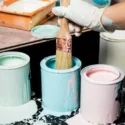How to Texture a Ceiling Easily for a Stunning Makeover
Are you tired of staring up at a plain, boring ceiling? Do you want to give your space a much-needed makeover?
Well, we have the answer for you!
Discover the secrets to texturing a ceiling with ease and transforming your room into a stunning masterpiece. Say goodbye to dull and hello to fabulous.
Preparing Your Ceiling
Before you begin texturing your ceiling, it’s important to prepare the surface. If you have popcorn ceilings, you’ll need to remove them first.
Lay down plastic sheets to protect your furniture and floors. Apply a primer and allow it to dry completely before moving on to the next step.
How to Apply the Texture to a Ceiling
Now that your ceiling is prepped, it’s time to apply the texture.
Step – 1: Applying the Texture
Mix the joint compound according to the manufacturer’s instructions. This will ensure the right consistency for easy application.
You can use a trowel or a roller to apply the texture to the ceiling. Make sure to pay special attention to the edges of the ceiling to ensure an even and seamless look throughout.
Step – 2: Letting it Dry
As you apply the texture, it’s important to let the ceiling dry completely before moving on to the next step.
This will allow the textured material to set properly, creating a durable and visually appealing finish.
Step – 3: Painting the Ceiling
During the application process, don’t forget to remove any light fixtures from the ceiling or cover them with plastic to protect them from the textured material. This will prevent any unwanted damage or staining.
By following these simple steps, you can successfully apply the texture to your ceiling and create a stunning transformation. The even application and proper drying will ensure a professional-looking finish that enhances the overall aesthetic of your space.
Achieving Different Textures
If you’re looking to add some visual interest to your ceiling, there are several techniques you can try to achieve different textures. These methods will give your ceiling a unique and personalized look, enhancing the overall aesthetic of your space.
Orange Peel Texture
One popular option is the orange peel texture. This technique creates a subtle texture that resembles the surface of an orange peel. To achieve this effect, mix a joint compound and water solution and apply it to the ceiling using a sprayer or roller.
The compound will create small bumps and divots, resulting in a textured finish that adds depth to your ceiling.
Skip Trowel Texture
Another technique to consider is the skip trowel texture. This method involves applying a thin layer of joint compound to the ceiling using a trowel.
Instead of smoothing it out completely, you lightly skip the trowel across the surface, creating thin ridges and irregular patterns.
This technique adds a subtle sense of movement and creates a slightly more pronounced texture compared to the orange peel technique.
Textured Paint
If you prefer a simpler approach, textured paint is an excellent option. Textured paints are available in various finishes, from fine sand-like textures to more pronounced patterns.
Simply apply the textured paint to your ceiling using a roller or brush, following the manufacturer’s instructions. The paint will dry to reveal the desired texture, adding dimension and visual interest to your space without the need for additional tools or techniques.
Whichever technique you choose, it’s essential to allow the texture to dry completely before moving on to the next step.
This ensures a durable finish and prevents any damage to the texture during the painting or finishing process. Be patient and allow sufficient drying time for the best results.
Note: This website is supported by readers and if you click on our links we may earn a commission and as an Amazon Associate, we earn from qualifying purchases.
Materials and Tools Needed
To texture a ceiling, you’ll need the following materials and tools:
- Joint Compound
- Texture Sprayer
- Drywall Knife or Texturing Brush
- Paint Roller
- Drop Cloths
- Safety Glasses and Mask
- Ladder
- Paint
Conclusion
By following these simple steps, you can easily texture your ceiling and give your room a stunning makeover. Whether you prefer a more traditional textured finish or want to experiment with different techniques like the popular orange peel or skip trowel, the end result will be a fresh and stylish update to your living space.
Remember to take your time and adhere to safety precautions throughout the process. It’s crucial to allow each step to dry completely for the best results. Patience is key when it comes to achieving a flawless textured ceiling.
With your newly textured ceiling, you can enjoy a renewed sense of style and ambiance in your home. So go ahead, get creative, and have fun transforming your space.
FAQ
The easiest way to texture a ceiling is to use a pre-mixed textured paint and apply it with a paint roller. This method requires minimal tools and creates a subtle, attractive texture.
To remove popcorn ceilings before texturing, you can use a scraper or a removal tool to scrape off the textured material carefully. Wear protective goggles and a mask to minimize potential health risks from the particles.
While using plastic sheets to protect your furniture and floors is highly recommended, you can also use drop cloths or canvas tarps as alternatives. These will help prevent any wet-textured material from getting onto your belongings.
The drying time for the primer can vary depending on the type and brand you use. Typically, the primer takes 4 to 6 hours to dry completely. However, it is best to refer to the manufacturer’s instructions for specific drying times.
The drying time for the textured material can vary depending on factors such as humidity and the thickness of the applied texture. On average, it takes 24 to 48 hours to dry completely. It’s important to allow sufficient drying time before proceeding to the next steps.



